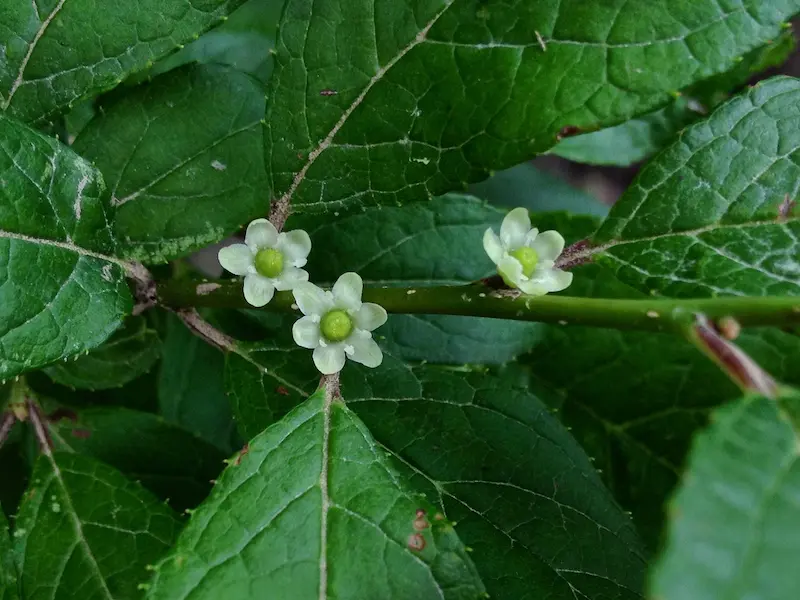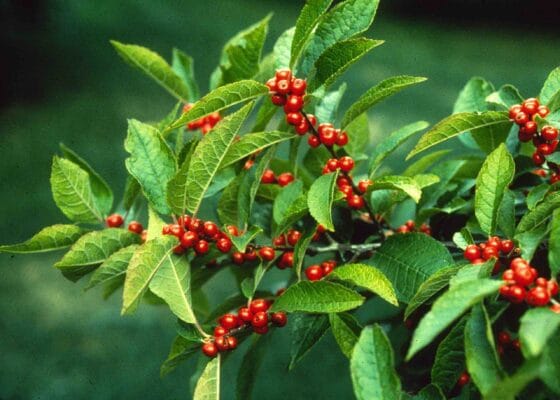Winterberry Growth and Care
Photo:
Skyler Ewing via Pexels
Winterberry holly has pointed, dark-green foliage that is surrounded by red berries. While the berries remain, the leaves fall off in late fall and early winter, leaving a stunning display of brilliant red fruit in your garden. The deciduous holly shrub is native to eastern North America and several Asian regions.
Once established, winterberries just need occasional watering and annual pruning in terms of care. Flowers must be planted in the right circumstances to appear and develop at their best.
Quick Growing Guide
Botanical Name: Ilex verticillata
Also Called: Black Alder, Coralberry
En français: Houx verticillé
Sun / Shade:
Water: Needs a lot of water and use groundcover.
Height:
Pollinators:
Caring for Winterberry
To produce berries on female trees, one male tree is required per planting. It’s simple to transplant. On high pH soils, it will become chlorotic, but it will tolerate slightly basic soils. Salt tolerance is possible. In the fall, the leaves turn black, hence the name Black-leaved Alder.
Male or Female Winterberry?
Winterberry is a plant, which means that plants have two genders. On male plants, flowers lack the female pistil because they are staminate. Furthermore, male flowers bloom in groups of seven to twelve, with no pistil in the centre of their flowers. On female plants, on the other hand, flowers are pistillate and grow either as single flowers or in groups of three flowers.

Credit: Fritzflohrreynolds, CC BY-SA 3.0 via Wikimedia Commons

Credit: Fritzflohrreynolds, CC BY-SA 3.0 via Wikimedia Commons
Appearance
Although it loses its green leaves in autumn, bright red berries will form in winter, creating a spectacular look.
White flowers, crimson berries, and prickly leaves are all produced by holly shrubs. Because of their connection to the Christmas season, they are well-liked additions to winter gardens. Beyond the winter season, you can enjoy their green foliage and vivid red berries because they thrive in early spring and late fall. USDA Hardiness Zones 3-9 are ideal for the shrub to flourish.

Planting
In nature, fid winterberry near swampy woods and thickets, peat lands, edge of woods.
Holly bushes require sunlight to thrive, but spending too much time in direct sunlight can be harmful to the plants. To avoid this, look for a location in your yard that receives equal sun and shade. For instance, landscapers frequently plant these shrubs near the foundations of homes.
The Winterberry is a species of holly and is best planted in autumn.
Because the plant won’t thrive in dry soil or a dry environment, prepare your planting place with well-draining, acidic soil and ground cover. In a large, deep trench, plant. Dig deep holes while considering the root ball’s size because your holly plants require enough space to grow both above and below ground. Aim for a size that is around twice the size of the actual roots. After planting your holly, give your bushes plenty of room to spread out because their root systems may get quite enormous. Water the area around the plant to settle the soil.
Care
Winterberry holly shrubs are perfect for moist or poorly drained sections of a home landscaping where little else will thrive because they naturally flourish in wetland habitats. If they get enough moisture, they’ll also develop in a range of environments.
Light
Planting a light Winterberry holly in either full sun or moderate shade will result in good growth. Plant the shrub where it will receive at least six to eight hours of direct sunlight each day to guarantee adequate flowering and fruiting.
Water
Winterberry prefers somewhat moist environments. If you aren’t prepared to give it frequent waterings, don’t plant it in dry soil or a dry climate. This plant will need at least an inch of water every week through irrigation or rainfall.
Soil
Although this plant can grow in both light and heavy soils, acidic loam with a high level of organic matter is where it thrives. In neutral to alkaline soil, which might result in deadly chlorosis, it performs badly (yellowing of the leaves). If a soil test shows neutral or excessively alkaline soil, feeding it with a fertilizer made for plants that like acid will help change the pH levels of the soil.
Temperature and Humidity
Winterberry has good resistance and tolerance for all temperature and humidity conditions throughout its hardiness zone, although it struggles with prolonged dryness.
Pruning
Every few years, prune the winterberry bush in the early spring to maintain control over its size. Use bypass shears to prune the entire shrub by a third. Instead of making a straight cut across the top, prune each branch individually to preserve the shrub’s natural growth pattern.
Fertilizer
Unless growth is extremely slow, winterberry holly normally doesn’t require feeding. It usually suffices to apply 1/2 cup of balanced 10-10-10 fertilizer every spring, if necessary. If a soil test shows neutral or excessively alkaline soil, feeding with a fertilizer made for plants that like acid can help change the pH levels of the soil.
Uses
As a herb, winterberry hasn’t been used much. Native Americans consumed bark tea as a tonic and diarrhea cure. They utilized a root remedy to reduce the symptoms of hay fever. Additionally, the bark has been applied topically to cure skin conditions, particularly when coupled with slippery elm bark, as well as orally to treat fevers, internal parasites, and liver illnesses. But these uses have not been demonstrated by scientific studies.
The leaves can be used to make tea by drying and crumbling them. Winterberry’s tea does not contain a lot of caffeine, in contrast to a few other hollies.
Getting it to Bloom
Since the main reason winterberry holly is grown is for its profusion of bright berries, it seems to reason that you’d want to make the most spectacular display possible. Your winterberry holly will blossom more aggressively depending on a few criteria, the first of which is the availability of compatible male and female kinds.
In the case of winterberries that don’t produce flowers or berries could be a problem for the genders: neither the female nor the male is located close enough to each other.
In the late spring, both sexes will produce tiny green-white flowers that, if properly pollinated, will eventually develop into berries on female plants. Examine the center of the flowers to distinguish the female from the male bushes. Female plants will have a little green nub in the middle, whilst male plants will have anthers that produce pollen.







Leave a Reply
You must be logged in to post a comment.